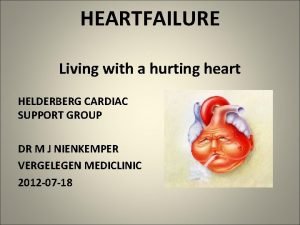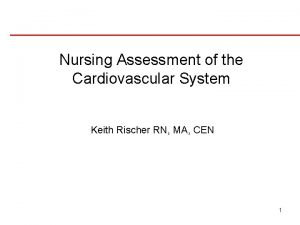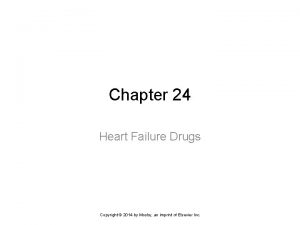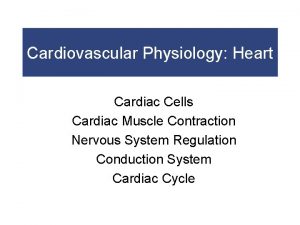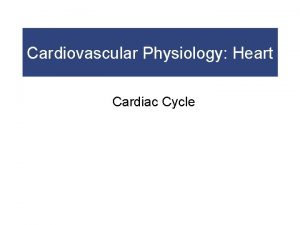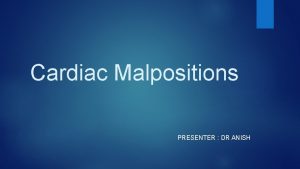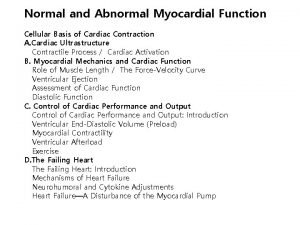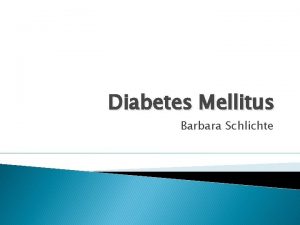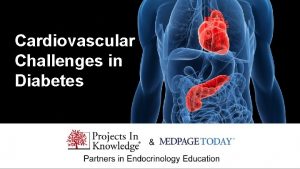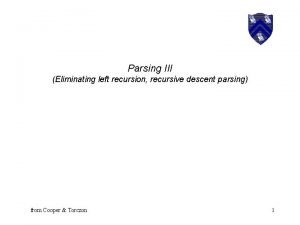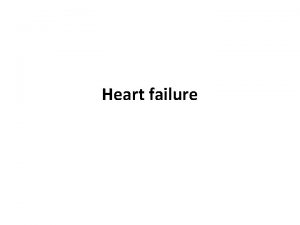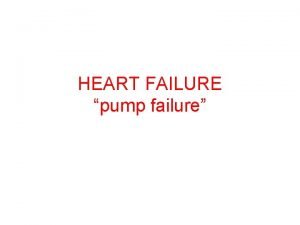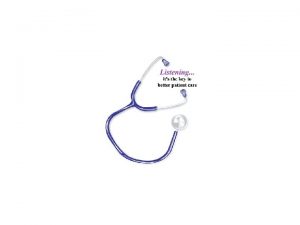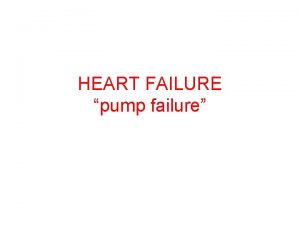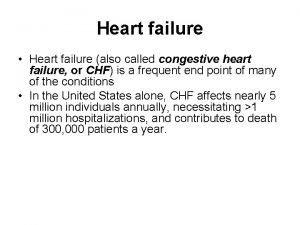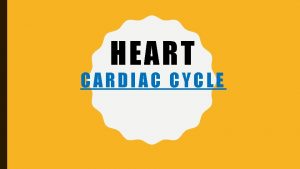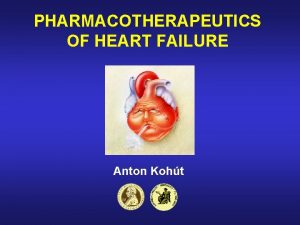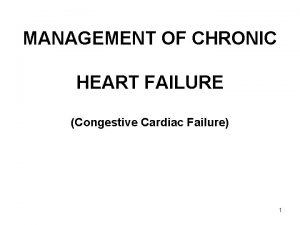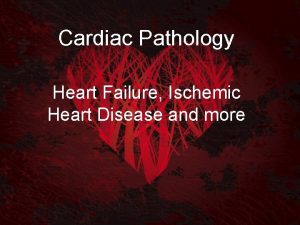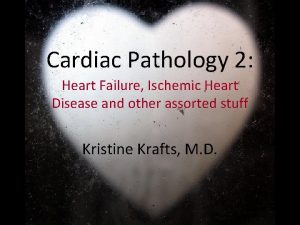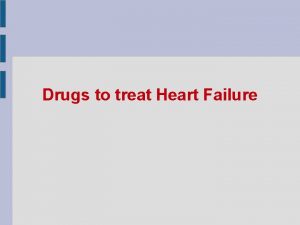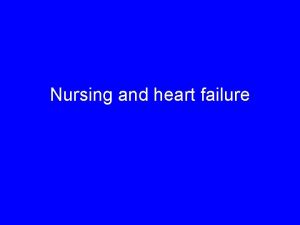Chapter 22 Cardiac Failure Left And Right Heart
























- Slides: 24

Chapter 22: Cardiac Failure

Left And Right Heart Pressures (120/80) (25/8) (0) (25/2) (120/8)

I. Causes of Cardiac Failure • • A. B. C. D. E. F. G. Myocardial infarction Heart valve damage Pulmonary embolism Anemia Myocarditis Hypertension - severe A-V fistula and Beriberi (high output failure)

II. Acute Responses to Cardiac Failure • A. Sympathetics (start 6 sec. max at 30 sec. ) • B. MSFP due to venoconstriction

III. Chronic Responses to Cardiac Failure • A. Renal Na and H 2 O retention Þ ? Blood volume and ¯venous resistance 1. Sympathetic constriction of afferent arterioles Þ (? GFR & U. O) ¯ GFR and ¯ Urinary Output 2. AII release Þ Na retention 3. ALDO release (from AII and K+ ) Þ Na retention

III. Chronic Responses to Cardiac Failure (cont’d) 4. ADH release Þ (? H 2 O balance) H 2 O retention 5. ¯ MAP initially then returns to normal • B. Cardiac recovery (repair of muscle) • C. ANF causes extra Na excretion

CARDIAC OUTPUT AND VENOUS RETURN (L/min) Compensated Heart Failure 15 10 2 nd day Autonomics + recovery Autonomic Normal 5 failure -4 -2 0 2 4 6 8 10 12 14 16 RIGHT ATRIAL PRESSURE (mm. Hg)

IV. Compensated Heart Failure • A. Features 1. Normal C. O. 2. RAP 3. ¯ Cardiac reserve 4. HR 5. Pale skin 6. Sweating also with nausea 7. Air hunger 8. Weight gain from fluid retention 9. Orthopnea

V. Decompensated Heart Failure • A. Causes 1. Fluid retention causes overstretched sarcomeres.

Sarcomere Length-tension Diagram 100 Tension developed (%) 50 0 2 3 4 1 Length of sarcomere (mm)

V. Decompensated Heart Failure (cont’d) 2. Edema of heart muscle 3. Longitudinal tubules of sarcoplasmic reticulum fail to accumulate enough Ca++. 4. Norepi in sympathetic nerves ¯’s

Decompensated Heart Failure

V. Decompensated Heart Failure (cont’d) • B. Treatment of Decompensated Failure 1. Diuretics 2. ¯ Na and water intake 3. ACE inhibitor 4. Cardiotonic drug 5. Breathe O 2 6. Heart transplant

VI. Left Heart Failure • • • A. LAP B. Pulmonary congestion C. Pulmonary edema D. AP may be normal E. CO may be normal

Left Heart Failure Left Heart Right Heart Pulmonary circulation has small volume and capacitance Systemic circulation has large volume and capacitance During left heart failure a relatively large amount of blood transfers from the systemic circulation into the pulmonary circulation and causes a big increase in LAP Þ C. O. from it’s low value.

VII. Right Heart Failure • A. Greater ¯ in C. O. than left failure • B. Peripheral congestion

Right Heart Failure Left Heart Right Heart Pulmonary circulation has small volume and capacitance Systemic circulation has large volume and capacitance During right heart failure a small amount of blood transfers from the pulmonary circulation to the systemic circulation. This causes a small increase in RAP Þ a small increase in cardiac output.

VIII. High C. O. Failure • A. Could lead to true heart failure • B. CO because of venous return caused by: 1. A-V fistula 2. Thiamine deficiency Þ beri 3. Thyrotoxicosis Þ BMR 4. MCFP due to Blood volume

IX. Cardiac Shock • A. C. O. is very low • B. ¯ C. O. Þ ¯ AP Þ ¯ coronary flow Þ weak heart Þ ¯ CO • C. Sympathetics or RAP (Starling’s Law) can break up this cycle

IX. Cardiac Shock (cont’d) • D. Treatment of cardiac shock 1. Digitalis 2. AP use digitalis and dobutamine (a and b stimulation) 3. Give volume expander 4. Dissolve blood clot if this is cause

X. Acute Pulmonary Edema • A. ¯ C. O. • B. pulmonary blood volume • C. ¯ Pa. O 2 Þ peripheral vasodilation Þ venous return Þ pulmonary cap. pressure Þ more and more edema • D. Listen for rales - also chest x-ray

X. Acute Pulmonary Edema (cont’d) • E. Treatment of acute pulmonary edema 1. Tourniquet 2. Bleed patients 3. Furosemide or diuretics 4. Breathe O 2 5. Digitalis 6. Bronchodilator

XI. Cardiac Reserve • A. Any type of cardiac failure ¯ reserve • B. If normal C. O. = 5 L/min and you can to 20 L/min; cardiac reserve = 15/5 * 100 = 300% • C. Test by exercise 1. Will cause dyspnea 2. Muscle weakness

XII. Diastolic Dysfunction • A. Decreased pumping is called systolic failure. • B. Decreased filling is called diastolic failure. 1. Will cause increased ventricular end diastolic pressure. 2. Happens often in left ventricular hypertrophy.
 Dr nienkemper
Dr nienkemper Get in the train
Get in the train Left left right right go go go
Left left right right go go go Right product right place right time right price
Right product right place right time right price Right time right place right quantity right quality
Right time right place right quantity right quality Right sided heart failure
Right sided heart failure Right ventricle failure
Right ventricle failure Heart surface anatomy
Heart surface anatomy Lower border of heart
Lower border of heart Ventricular escape rhythm
Ventricular escape rhythm Failure to sense vs failure to capture
Failure to sense vs failure to capture Cup cone failure
Cup cone failure Chapter 24 heart failure drugs
Chapter 24 heart failure drugs The right man on the right place at the right time
The right man on the right place at the right time Membrane potential of cardiac muscle
Membrane potential of cardiac muscle Cardiac output and heart rate
Cardiac output and heart rate Left border of relative cardiac dullness
Left border of relative cardiac dullness Lvedp normal range
Lvedp normal range Chlorpromide
Chlorpromide Diabetes and heart failure
Diabetes and heart failure Cardiac dullness
Cardiac dullness Coronary sulcus
Coronary sulcus Go straight and turn right
Go straight and turn right Left factoring algorithm
Left factoring algorithm Heart failure definition
Heart failure definition
